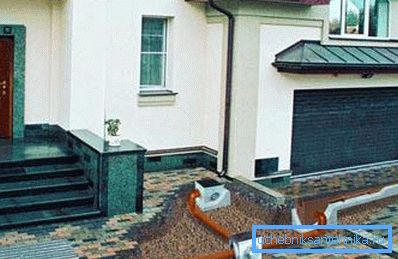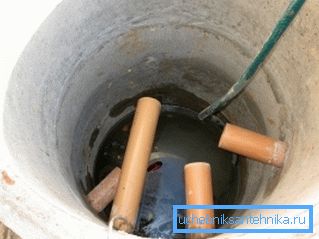How is rainwater sewer design?
Sometimes it happens that thawed or rainwater can flood basements and large areas due to rising groundwater levels, causing the appearance of puddles and waterlogging sites. In this case, it is necessary to provide for their collection, transportation and dumping outside the residence. For this, storm or rain sewers are designed according to SNiP.

What we consider in the article
In the article below we will consider:
- its main functions;
- design principles;
- system calculation;
- arrangement.
Tip: Experts recommend not to postpone the creation of stormwater, as you can increase the life of objects built on a country site.

Types of rainwater disposal
According to the variant of precipitation, three possible types of storm sewers are distinguished:
| Open | In this case, the system is open:
|
| Closed | The water collected by drainage trays is sent through rain wells into the drain pipe, often equipped with sewage treatment plants. It directs flows to the drop point. |
| Combined | There is a combination between the two types, when part of the open elements are replaced by an underground pipeline. |
Tip: it is strictly forbidden to discharge rainwater into the drainage system, which is designed to protect the foundation of a residential building from high humidity.
Otherwise, in the period of heavy melting of snow and heavy rains, it will be destroyed by excess water. You must make a separate drainage outlet.

Installation recommendations
Below is a guide to understand the details of the process:
- Storm sewers are laid parallel to the drainage system. At the same time, it is necessary to monitor its angle of inclination, which should be 5 mm per meter.
- A drainage pipe can be laid on top of the drainage pipes if they are buried deep. In this case, before laying it is necessary to carefully tamp the soil over them, since you will save them from damage.
- A cushion of rubble or sand 50-100 mm high should be placed under the pipeline.
- Use for rain sewer pipes made of high-strength polypropylene, having a corrugated outer surface and a smooth inner. Their price is lower than metal.
- To connect pipes to each other, use a double sleeve and a rubber seal.

- Mount the funnel, which will receive water, a little higher or in the same plane with the lower end of the pipeline. It is necessary for filtering large debris, including branches and leaves from trees.
- You can connect the drainage well to which water enters through the pipeline directly to the main waste collector or to the sewage system at the site.
Tip: install a ball check valve on the inside of the drain well connected to the drain pipe, which will prevent the excess water level from rising into the drainage system and then to the foundation.
- It is believed that the minimum height between the bottom of the check valve and the tube tray should be 120 mm. Install a coupling at the top of the well, allowing the pipe to be lengthened to ground level.
- The finished system should consist of:
- well;
- extension pipe;
- mouths with a cover.
- Cover the system with sand or gravel and tamp the layer.
Tip: rainwater drainage is diverted to roadside ditches, various water bodies or a centralized sewer.
From the latter, the water usually goes into the communal storm sewer, open sod or soil, through a layer of rubble. If the last two options are used, the pipe should be closed with a protective metal grill that will not allow animals to enter the pipeline.
Design tasks
Rainwater should be diverted in any cottage settlement or city, in a private house or enterprise (see also the article Depth of the sewage system - the main aspects of this issue).
Since the load on the system in each of them will be different, moreover, the specificity of the object leaves its imprint, the design of storm sewers includes several important features:
- calculation of hydraulic resistance;
- tracing;
- the creation of basic elements.
Of course, you can cope with this task on your own in a limited area, but for large objects it is better to invite specialists. They will conduct a thorough analysis of the conditions of the upcoming operation, take into account the area of the site, its topography, the volume of water and because of what it can become contaminated. There will also be considered the issue of collecting and dumping the accumulated moisture in specially designated places.

By means of tracing, the collection of melt water from the entire site and its removal with the help of a drift to the place of discharge and treatment along the shortest path is provided. In this case, the territory is divided into basins, on each of which a collector is installed with a release or connected with other similar structures.
When calculating the rain sewer is taken as a basis:
- data on the average rainfall in a particular region;
- their maximum number;
- terrain, which affects the rate of flow of rainwater;
- catchment area;
- nearby ponds.

From this directly depends:
- the choice of the type of sewer system;
- its location;
- number of drainage wells;
- diameter and length of pipes.
Conclusion
From this article, you learned that rainwater drainage is a way to remove excess water from the site, which makes it possible to avoid many troubles and ensures the normal operation of the territory and facilities on it. It was also told about the types of storm sewers, the features of its design and installation (see also the article Septic tanks for sewers - a key element of an autonomous sewage system).
The video in this article will help you find additional information on this topic.